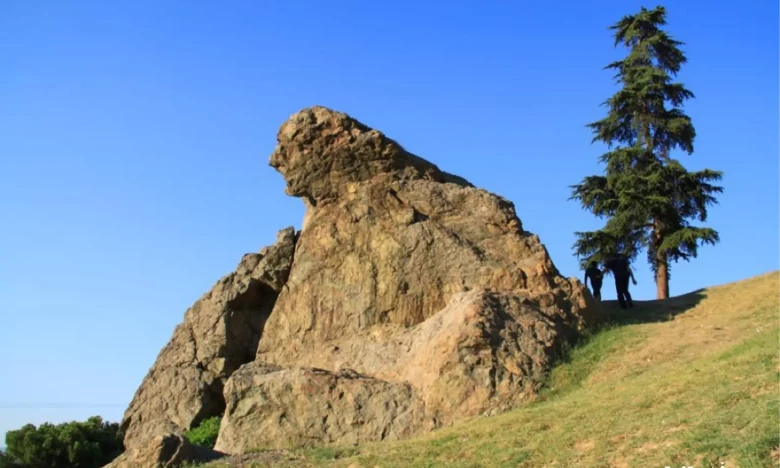According to legend, this rock, formed when a prideful mother was petrified by the gods, bears Niobe's tears in every drop. Even today, the drops of water that drip from its surface serve as a reminder of her eternal mourning.
What is the Legend of Weeping Rock?
One of the legends passed down from mouth to mouth in the ancient lands of Anatolia is the legend of the Weeping Rock (Niobe Rock). This story is the echo of a myth steeped in pain, pride, and ancient punishment.According to legend, a towering rock mass lies at the foot of Mount Spil (or "Mount Sipylos" in ancient sources) within Manisa. While it may appear like an ordinary rock from the outside, from a distance or from the right angle, it captures the eye with a silhouette reminiscent of a woman with her head bowed, her inner sorrow and silent tears. This rock is known among locals as the "Weeping Rock" or "Niobe Rock."
It is said that from time to time, water droplets leak from eye socket-shaped indentations on the rock's surface - the people interpreted these drops as Niobe's eternal tears for their deaths.
The Story of the Legend: The Tragic Story of Niobe
The story of Niobe is one of the most touching stories in mythology, where pride turns into tragedy and a mother's love turns into immortal legend.Mythological Origin
The legend of the Weeping Rock is linked to the character Niobe from Greek mythology. Niobe was the daughter of the Lydian king Tantalus and his wife Dione. Some sources state that she was born and raised in Manisa.When Niobe grew up, she married Amphion, King of Thebes. The number of children born from this marriage is reported to be 6 girls + 6 boys, equaling 12. However, some ancient sources also give the number of children as 14: 7 girls and 7 boys.
Pride and Insult
Niobe boasted about her many children, particularly emphasizing that the goddess Leto had only two children, thus highlighting this distinction among the people. This prideful rhetoric cost her dearly. Legend tells that Niobe's arrogance put her life among the gods at risk.Leto's children, Apollo and Artemis, hear that their mother's name has been insulted. They decide to punish this arrogance, which would disrupt the balance among the gods. Apollo kills Niobe's sons with his arrows, while Artemis kills her daughters. Thus, Niobe loses all her children.
Niobe cried for days over the bodies of her children, and in her unbearable pain, she cried out to the gods for help. Zeus took pity on her pain and turned her into a rock. But according to legend, even the rock continued to weep—drops of water dripping from its surface symbolized Niobe's mourning.
Where is Weeping Rock? How to Get There?
- Location : Weeping Rock is located within the borders of Manisa province, at the northwestern foot of Mount Spil. It is popularly known as the "Dere Mahallesi (Karaköy/Çaybaşı area)."
- Transportation : It's possible to reach this rock by climbing Mount Spil from Manisa city center, along mountain roads. Driving can reach certain points by following the mountain road; the rest can be done on foot. (The location can be easily found with the help of local maps and directional signs.)
- When to Visit : While the rock appears dry most of the time, water droplets can be observed flowing from its surface during rainy or humid weather. Therefore, a visit in spring or after rainfall can be even more impressive if you wish.
Between Myth and Reality
Although the legend of the Weeping Rock is covered with mythological elements, it can also be related to geographical and geological facts:- The fact that the head of the rock resembles a woman leaning forward and that the indentations on it leak water may be due to natural erosion and the characteristics of the rock structure.
- The “tear drops” interpretations can also be explained by the water seeping through the porous structure of the rock combining with light to create a visual effect.
- The legend reflects people's sensitivity to tragedy and metaphor: it persists in cultural memory as a myth filled with universal themes such as pain, pride, punishment.
Why Visit?
Meeting with Mythology : An impressive route for those who want to touch the ancient myths of Anatolia and be alone with the shadows of the past.Nature and Landscape : The nature of Spil Mountain, the surrounding landscape and the dramatic view of the rock silhouette, especially at sunrise/sunset moments, offer a different atmosphere to visitors.
Photography & Observation : Especially for photography enthusiasts, the "crying woman" image created by the rock depending on the shadows, light and angles is interesting.
Local Culture Connection : It is possible to experience the region more deeply through Manisa's legends, villages and mountain roads.
What to do at Weeping Rock?
Weeping Rock, one of Manisa's most striking natural formations, offers visitors a delightful experience not only with its legend but also with its stunning scenery and peaceful atmosphere. Located at the foot of Mount Spil, this captivating rock is an unforgettable destination for those interested in both mythology and nature. Here, you can not only experience the historical atmosphere but also spend time immersed in nature, completing the day with a delightful experience. Let's explore what you can do at Weeping Rock.Its View and Quiet Peace
The most captivating aspect of Weeping Rock is the view of Manisa's city stretching from the slopes of Mount Spil. The view from the rock's surroundings, especially in the early morning or at sunset, offers visitors a peaceful experience. When you examine the legendary rock closely, you can almost sense the emotion of the myth, resembling the silhouette of a woman with her head bowed. For photography enthusiasts, this place offers the opportunity to capture stunning shots of the dance of light and shadow.Activities in the Area
Weeping Rock is not only a mythological symbol, but also a pleasant excursion spot for those who want to be alone with nature.- Nature Walks : You can explore the surroundings and enjoy the fresh air with short walking routes on the slopes of Spil Mountain.
- Photo Shoot: You can immortalize the atmosphere of the legend by photographing the silhouette of the rock and the mountain view behind it at different times of the day.
- Listening to the Legend : Hearing the story of Niobe from the local people turns your visit into a meaningful cultural experience.
- Viewing the Landscape : Sitting quietly and spending time in front of the rock allows you to feel both the peace of nature and the sad spirit of the legend.







